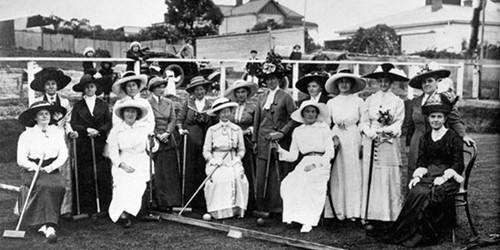This year, YPRL is celebrating International Women’s Day all week! The theme for 2021 is Choose to Challenge.
For today’s spotlight, we want to challenge the family historians among us to uncover the stories of our female ancestors.
As always, follow or review the beginners’ steps:
- Summarise known names, dates, relationships and family traditions.
- Gather records and memorabilia from around the house. Are their family heirlooms such as jewelery, crockery, a vase that has been kept through the generations? Is there an old quilt or sampler? Needlework was customarily taught to girls at school.
- Pull out your photos. Identify and analyse them: what story can they tell you? Examine the setting and look for background information. Is there a family Bible? Are there letters and/or diaries?
- Gather oral history: ask open-ended questions. Verify family stories through civil registration records and find married names. Consider that your ancestor may have married more than once.
The opposite challenge may be to determine a married name. Look for death notices, obituaries and wills for the father. The married daughter may be mentioned. - Consider the use of naming patterns. Research the immediate family, such as brothers and sisters of your female ancestor, and find your relatives in school records.
- Check the witnesses for baptisms and weddings — your female relative may have been one.
- Search for your first record in the country (a death certificate will indicate how long they were in the colony). Perhaps your ancestor came out on a women-only emigration scheme. Some orphan girls were part of the Earl Grey emigration scheme to Australia between 1848 and 1850. There are also a couple of projects devoted to female convicts including the Parramatta Female Factory.
- Hunt for headstones: Epitaphs may reveal a wide range of details about an ancestor’s life.
Ivanhoe Croquet Club, 1913. Yarra Plenty Regional Library in partnership with Heidelberg Historical Society.
Search Tips
Search everywhere! Both online and offline. Begin by searching broadly, then narrow down and use non-traditional resources such as the local history catalogue for the public library where your ancestor lived, hospital records, or even prison records.
If you can, avoid including the surname in your search. Instead, use other identifying information such as birth or death date or relationships. This trick works well if you have an uncommon first name.
Be mindful of your spelling. Some names may have been abbreviated in the records e g. Marg’t for Margaret.
Historical newspapers via Trove, Gale Primary Sources and British Newspapers Archive are worth looking at. Often women were not recorded with their first name, but initial or marital status only, such as “Mrs T. Ryan”. Combine these kind of searches with a place name to narrow down your search results. Your ancestor may appear in featured news articles, social news, obituaries, or birth, marriage, death, and funeral probate notices.
Be mindful that names can be anglicised, shortened, and spelt in numerous ways. Christian names were often interchangeable, for example Anna and Hannah.
Make a note of the differing spelling variations that may exist for your surname and the personal name you are researching. Elizabeth could be found under Liz, for example.
Find your Australian ancestor in the electoral rolls via Ancestry and Census Records in other countries via Ancestry, Find My Past and FamilySearch.
Consider creating a timeline for your ancestor. Include birth, marriage and births of children, and fill in the gaps in between. Gather and share the stories of your female ancestors today!
Explore these Resources
Petition, from 'Ladies Resident on Plenty River' requesting protection from bushrangers.
Index to Royal Women's Hospital (formerly Melbourne Lying-In Hospital) 1856-1879.
Midwives of Essendon and Flemington Index
1891 women’s suffrage petition
The Australian Women’s Register
Bal Maidens Cornwall & Devon (searchable database of women miners)
And from our collection:
Tracing your female ancestors: a guide for family historians
Be sure to visit the other posts in this blog series — we'll be publishing one each day throughout the week.
You can also visit our curated list on the catalogue for recommended reading from our collection to celebrate International Women's Day 2021.

